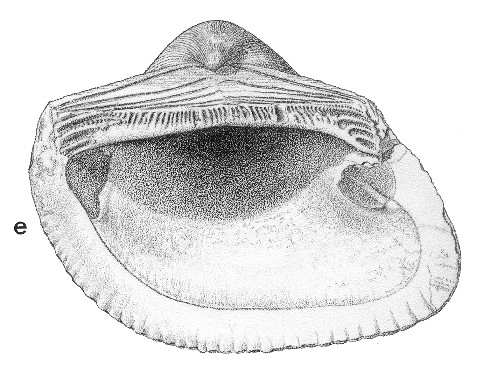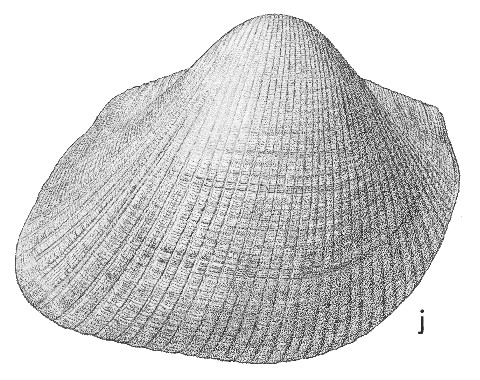
Revised descriptions of New Zealand Cenozoic Mollusca from Beu and Maxwell (1990)

 | Revised descriptions of New Zealand Cenozoic Mollusca from Beu and Maxwell (1990) | 
|
  (Pl. 10e): GS 1473, I40/f9519, Trig Z, Otiake, Waitakian (TM2850, GNS, specimen illustrated by Boreham 1965, pl. 2, fig. 1, 4) |
  (Pl. 10j): GS 1473, I40/f9519, Trig Z, Otiake, Waitakian (TM2850, GNS, specimen illustrated by Boreham 1965, pl. 2, fig. 1, 4) |
Beu & Maxwell (1990): Chapter 10; p. 142; pl. 10, e, j.
Synonymy: Cucullaea worthingtoni Hutton 1873b, p. 27
Classification: Cucullaeidae
Description: Large for genus (length 80-110 mm), thick-shelled, oblong or somewhat oblique, strongly inflated, left valve larger than right, overlapping along ventral margin. Umbones prominent, situated near middle of dorsal margin. Posterior area flattened, with an indistinct sulcus near middle. Sculpture discrepant, left valve with broad, low, flattened costae with linear interspaces over middle of shell, becoming much narrower and more crowded towards anterior end, and very subdued on posterior part of flank and towards ventral margin. Numerous fine threads but no costae on posterior area. Right valve with similar but more prominent costae than on left valve, also becoming weaker and more crowded anteriorly but extending further posteriorly, onto anterior part of posterior area, and remaining strong right to ventral margin; interspaces wider than on left valve, particularly anteriorly. On both valves some costae bear a narrow median groove, and all are crossed by numerous, fine growth lines, those on right valve interrupted by intercostal grooves. Hinge very prominent, ends with 3-6 subhorizontal, straight or slightly curved, transversely striate teeth, remainder with numerous small, iregular vertical or sloping striate teeth. Cardinal area large, triangular, with 6-8 incised, rather irregular chevron-shaped grooves; some well preserved shells with ligament material partly retained. Adductor muscle scars large, typically differently preserved from rest of shell, posterior scar with pronounced myophoric ridge. Ventral margin strongly denticulate except on some very large shells where the margins become thick and grow in towards each other; denticulations also absent from posterior margin and dorsal part of anterior margin.
Comparison: Hutton (1873b, p. 27-28) described two other large mid-Tertiary species of Cucullaea, C. attenuata (Duntroonian?, Lake Wakatipu) and C. ponderosa (Lillburnian?, Korakonui, East Wellington), which were distinguished from C. worthingtoni on the basis of shape differences. Boreham (1965, p. 8-13) carried out a biometric study of Cucullaea from Wharekuri (Duntroonian) (assigned to C. attenuata), Trig Z, Otiake (C. worthingtoni) and Cucullaea Point, Clifden (Lillburnian) (C. ponderosa) and found that although there is considerable overlap between the three samples, scatter diagrams of hinge length vs shell height could be used to discriminate between them. Specimens assigned to C. attenuata are relatively elongate (and oblique) and have a long hinge-line, whereas those included in C. ponderosa are considerably higher relative to length and have a relatively short hinge. C. worthingtoni falls between these two species in shape and in hinge development. It should be emphasised, however, that the differences between these taxa are statistical in nature and as a consequence, individuals may not always be readily assignable to species (see Boreham 1965, p. 8-13, for a detailed discussion).
The status of other New Zealand species of Cucullaea (Latiarca) is more doubtful. C. australis (Altonian, White Rock River) was based on a juvenile shell, but according to Boreham (1965, p. 11) some specimens of Cucullaea from Altonian localities in North Otago and South Canterbury fall within the range of variation of C. worthingtoni, others within that of C. ponderosa, so C. australis should probably be synonymised with one or the other of these species. C. waihaoensis (? Porangan, Bortonian-Kaiatan) seems to be similar in shape to C. attenuata (Boreham 1965, p. 11) but the largest known specimens (length 70-80 mm) do not begin to approach the latter species in size, so it is probably best regarded as a distinct species. C. hamptoni (Tongaporutuan-Kapitean) is similar in shape to C. ponderosa and although most specimens are smaller than typical adult C. ponderosa and it allegedly differs in sculptural details, it is probably not distinct.
The subgenus Cucullaea (Latiarca), which is based on an Eocene species from Maryland, USA, was present in New Zealand from at least late Dannevirke Series until the end of early Kapitean time (end of the Globorotalia conomiozea zone), and was a characteristic member of most shallow-water (shelf) assemblages during this period. Rarer (and considerably smaller) specimens occur in deeper-water (upper bathyal) faunules. The subgenus C. (Cucullastis) Finlay and Marwick, 1937 is superficially similar to C. (Latiarca), but the type species, C. (Cucullastis) barbara (Pl. 1a, c), has a broad, shallow median sulcus, which forms a shallow sinus in the middle of the ventral margin, and has more markedly discrepant radial sculpture. This consists of broad, flat-topped costae in the right valve (i.e. like C. (Latiarca) species) and narrow, rounded costae and fine threads on the anterior and middle portions of the left valve. As noted under the Paleocene species, the distinctions between these subgenera are tenuous, and not recognised by most authors.
Distribution: "Waitaki" (type — probably from Otekaike Limestone, Waitaki Valley); Otekaike Limestone, Trig Z, Otiake; Campbell Park School, Otekaike.
Cite this publication as: "A.G. Beu and J.I. Raine (2009). Revised
descriptions of New Zealand Cenozoic Mollusca from Beu and Maxwell (1990). GNS
Science miscellaneous series no. 27."
© GNS Science, 2009
ISBN
978-0-478-19705-1
ISSN 1177-2441
(Included with a PDF facsimile file
copy of New Zealand Geological Survey Paleontological Bulletin 58 in CD version
from: Publications Officer, GNS Science, P.O. Box 30368 Lower Hutt, New
Zealand)